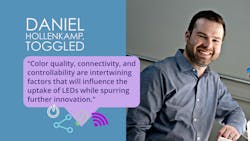Policy ushers smart lighting technology to center stage
After two prior presidential terms, the Biden Administration’s Department of Energy officially announced a series of steps for the U.S. to lower greenhouse gases, including setting stricter energy efficiency standards for light bulbs. This direction from the federal government will effectively phase out the sale of incandescent lamps by the year 2023.
Within the DOE’s order specific to light bulbs, there are three set rules: 1) Lamps must deliver a minimum of 45 lm/W efficacy; 2) old lamps that don’t meet the new standard will need to be phased out of production within 75 days; and 3) full enforcement of the rule will go into effect in July 2023.
While this order to phase out incandescent lamps makes sense considering the more energy-efficient lighting alternatives now available on the market, the lighting industry already had been moving in this direction for years as the federal government realized the high cost and energy consumption of conventional lighting. In fact, the initial DOE L-Prize program was launched to speed product development of more capable LED replacement lamps.
One of the biggest downsides of Edison-style bulbs is that they use more power to generate light with excess heat transmitted as wasted energy, whereas LEDs use at least 75% less power and last up to 25 times longer. Many LED replacements have met or exceeded the 45-lm/W efficacy requirement prior to the DOE's latest policy.
In 2007, the government passed a law decreeing that light bulbs must be three times more efficient by the year 2020. But once that deadline hit, 30% of light bulbs sold in the U.S. still used incandescent or halogen technology, according to Marketwatch. The market has already demonstrated that LEDs can save hundreds of dollars over the lamp lifetime, essentially paying for themselves and then some.
Considering the clear differences between incandescent and LED lamps in energy cost and efficiency, one may wonder why hesitation to adopt LEDs persisted for nearly two decades. In short, even with advances in lifetime and efficacy, incandescent lamps had delivered better quality of light. They were better suited for brightening and dimming than earlier generations of LEDs, and they delivered better color quality. Because of this, businesses and consumers have been willing to pay more for frequent replacements rather than sacrifice the quality of light.
Fortunately, the lighting industry is addressing deficiencies such as dimming to warm with acceptable and reliable performance. For instance, in August 2021, one global technology company acquired a patent for dimmable LED light technology that enables consumers to replicate the ambience and color performance of incandescent lights, but with advanced controls capability.
Smart features represent another incentive for both consumers and businesses to complete this transition to LED lighting, easing the way for energy monitoring and management and proving out the return on investment. A connected lighting system, including smart LEDs, sensors, and controllers, provides additional layers of energy savings beyond the initial efficiency of LED illumination alone, since the end user can control settings from their mobile device, or in the case of multiple building systems, from a central control dashboard.
Building operators and end users can customize lighting preferences through room scene creation, color tuning, and smooth dimming, replicating those pleasing features of incandescent lamps but with greater granularity, compounded energy savings, and the opportunity to apply insights not available without connectivity. By collecting and analyzing occupancy, environmental, and space utilization data, owners can identify commercial and industrial spaces that may be underperforming, require maintenance, or may be underutilized, allowing for future efficiency adjustments or more modular space designs.
With the latest efficiency regulation from the Biden Administration, LED-based smart lighting can officially take center stage in providing a customizable energy-efficient ecosystem so many have dreamed about. Color quality, connectivity, and controllability are intertwining factors that will influence the uptake of LEDs while spurring further innovation. The time is now for widespread adoption, which will lead to securing a more sustainable future in our built environment.
Get to know our expert
DANIEL HOLLENKAMP is chief operating officer at Toggled, a wholly owned subsidiary of Altair, providing efficient LED lighting and networked building products. Hollenkamp is responsible for Toggled’s day-to-day operations, overseeing sales, marketing, manufacturing, and research & development. Previously, he was Toggled’s lead manufacturing engineer, where he ramped up the company’s mass production efforts. He has more than 12 years of experience in electronics manufacturing and seven years of experience in the LED industry. Hollenkamp earned a bachelor’s degree in electrical engineering from Michigan Technological University.
*Toggled offers smart lighting and connectivity products such as those mentioned in this article.
This article has been extended with additional text — abridged version published in the July/August 2022 issue of LEDs Magazine.
For up-to-the-minute LED and SSL updates, follow us on Twitter. You’ll find curated content and commentary, as well as information on industry events, webcasts, and surveys on our LinkedIn page and our Facebook page.

Daniel Hollenkamp | Toggled Chief Operating Officer
DANIEL HOLLENKAMP is chief operating officer at Toggled, a wholly owned subsidiary of Altair, providing efficient LED lighting and networked building products. Hollenkamp is responsible for Toggled’s day-to-day operations, overseeing sales, marketing, manufacturing, and research & development. Previously, he was Toggled’s lead manufacturing engineer, where he ramped up the company’s mass production efforts. He has more than 12 years of experience in electronics manufacturing and seven years of experience in the LED industry. Hollenkamp earned a bachelor’s degree in electrical engineering from Michigan Technological University.





